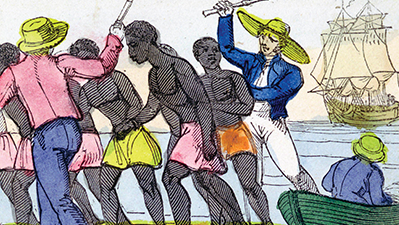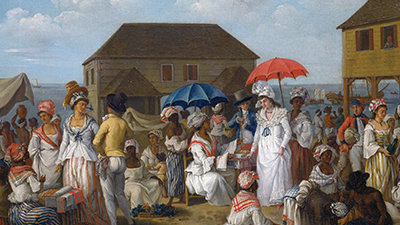The Plantation System
Teacher Resources
Driving Question: How was slavery in the Atlantic plantation system different from earlier forms of slavery?
The millions of Africans who were enslaved and forced to work in the Americas provided the labor that fueled the plantation system. This system enriched slavers as well as European empires. Enslaved people were treated as property, and the transatlantic slave trade was accompanied by the development of racial theories and ideologies that sought to justify the enslavement of Africans based on perceived racial hierarchies.
Learning Objectives:
- Understand and critique the motives and justifications for the transatlantic slave trade.
- Evaluate how conceptions of race affected communities and labor systems.
Vocab Terms:
- abolish
- colony
- enslave
- exploit
- hierarchy
- plantation system
Opener: The Plantation System
To teach this lesson step, refer to page 2 of the Lesson 3.7 Teaching Guide.
Check out this topic page to learn about all the ways we approach sourcing at OER Project.
As you prepare to learn about enslavement and the plantation system, this activity asks you to examine an image and compare it to what you already know.
Enslavement in the Americas
To teach this lesson step, refer to page 3 of the Lesson 3.7 Teaching Guide.
Check out the OER Project Differentiation Guide to ensure you’re modifying materials appropriately for your students.
Slavery has existed for thousands of years. In these two articles and activity, we grapple with the unique system of enslavement that emerged in the sixteenth-century Americas.
-
Guiding Questions
-
Before you read
Preview the questions below, and then skim the article. Be sure to look at the section headings and any images.
While you read
Look for answers to these questions:
- What was the legal status of enslaved people of African descent in the Americas?
- How did this legal status impact enslaved people’s experiences?
- What information does the advertisement announcing the escape of an enslaved person in Jamaica give us about the person named York?
- How did laws and beliefs around race impact enslaved people and free people of color?
- What information do the articles from the French Code Noir give us about the way race worked in the French colonies in the Americas?
After you read
Respond to this prompt: Using the evidence in this article, write a definition of slavery that fits the time and place described in the article.
-
Guiding Questions
-
Before you read
Preview the questions below, and then skim the article. Be sure to look at the section headings and any images.
While you read
Look for answers to these questions:
- What contradiction does the system of slavery in the Americas highlight?
- What was the principal motive for using enslaved labor?
- How were the people in William Clark’s 1823 painting Cutting the Sugar Cane, Antigua, economically related to Harewood House in Leeds?
- In what ways did people use religion to justify slavery?
- In what ways did people misuse science to argue in favor of slavery? Were these arguments sustained by evidence?
After you read
Respond to this question: What is the difference between a “motive” and a “justification,” as the author uses them in this article?
Closer: The Plantation System
To teach this lesson step, refer to page 4 of the Lesson 3.7 Teaching Guide.
Now that you’ve finished the lesson, use this quick closer to think about what you’ve learned.





